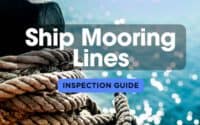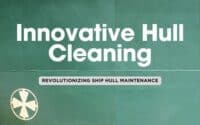10 Proven Strategies to Extend Your Ship’s Hull

The hull of a vessel is one of its most critical components, directly affecting fuel efficiency, speed, and overall durability. Neglecting hull maintenance can lead to costly repairs, higher fuel consumption, and even safety issues. Extending the lifespan of your vessel’s hull can save you time and money in the long run. Here are 10 effective ways to ensure your hull remains in top condition for decades to come.
| ShipUniverse: Top 10 (Prioritized by lowest cost) | |||
|---|---|---|---|
| Item | Description | Lifespan Impact | Cost |
| Regular Hull Cleaning and Biofouling Management | Removes marine growth to reduce drag and corrosion. | * | $ |
| Protective Anodes for Corrosion Prevention | Sacrificial anodes prevent hull corrosion by corroding themselves. | ** | $ |
| Routine Inspections for Early Detection of Damage | Identifies cracks, corrosion, and wear before they become major issues. | ** | $$ |
| Regular Hull Thickness Measurements | Monitors steel thickness to detect areas weakened by corrosion or wear. | *** | $$ |
| Applying High-Performance Antifouling Coatings | Prevents marine organisms from attaching to the hull, reducing drag. | ** | $$$ |
| Upgrade to Higher-Grade Hull Paint Systems | Provides long-term corrosion and UV protection, improving fuel efficiency. | ** | $$$ |
| Cathodic Protection Systems | Advanced corrosion prevention through impressed current systems. | **** | $$$$ |
| Hull Reinforcement with Composite Materials | Strengthens vulnerable sections of the hull with lightweight composites. | *** | $$$$ |
| Advanced Coating Technologies (Ceramic or Nano-Coatings) | High-performance coatings offer superior protection and reduced drag. | **** | $$$$ |
| Structural Hull Modifications or Upgrades | Involves major structural changes or reinforcements to extend vessel life. | ***** | $$$$$ |
#1 Regular Hull Cleaning and Biofouling Management
Marine biofouling is a significant issue for vessels, as it leads to increased drag, higher fuel consumption, and can even cause long-term damage to the hull. Organisms like barnacles, algae, and mussels attach to the hull, negatively impacting performance. Regular hull cleaning is essential to maintaining the vessel's efficiency and preventing corrosion or damage to the protective coatings.
- Frequency: It's recommended that commercial ships undergo hull cleaning every 6-12 months, depending on their operational area and duration of voyages.
- Methods: Hull cleaning can be performed underwater by divers or robots using high-pressure water jets, or in dry dock for more comprehensive cleaning.
- Impact on Efficiency: According to studies, biofouling can increase fuel consumption by up to 40%, so regular cleaning can lead to significant fuel savings and reduced operational costs.
- Cost Benefits: Though cleaning can be an upfront expense, it quickly pays off through lower fuel usage and fewer repairs due to corrosion caused by biofouling.
#2 Protective Anodes for Corrosion Prevention
Steel hulls are highly susceptible to corrosion, especially in saltwater environments. Installing sacrificial anodes is one of the most cost-effective ways to protect the hull from corrosion. Sacrificial anodes, often made from zinc, aluminum, or magnesium, are strategically placed on the hull to corrode instead of the steel, thereby protecting the vessel.
- How It Works: Sacrificial anodes work by acting as the first line of defense against corrosion. The metal in the anodes corrodes instead of the steel hull, prolonging its lifespan.
- Replacement Frequency: Anodes need to be checked and replaced regularly, typically every 1-2 years, depending on the water salinity and ship's operational profile.
- Cost Benefits: While anodes are relatively inexpensive (costing a few hundred dollars each), their impact on reducing hull corrosion is significant. By protecting the hull, they can prevent costly repairs or replacements due to corrosion damage.
- Installation: Anodes are typically installed during dry-docking, but they can also be fitted during in-water maintenance for smaller vessels.
#3 Routine Inspections for Early Detection of Damage
Routine hull inspections are vital for identifying early signs of damage or wear that could lead to more significant issues if left unchecked. Regular inspections allow shipowners to address minor damage, such as cracks, corrosion, or abrasions, before they develop into larger, costlier repairs.
- Inspection Frequency: Routine inspections should be carried out at least every 6 months, with more thorough assessments during dry-docking or major maintenance intervals.
- What to Look For: Inspections typically focus on identifying cracks, rust, pitting, and wear around high-stress areas such as the bow, stern, and near the propeller. Checking for coating degradation is also crucial.
- Benefits: Early detection can prevent major hull failures, reduce repair costs, and improve the overall safety of the vessel. Studies show that early intervention on minor hull issues can extend the vessel’s lifespan by 10-15 years, depending on maintenance quality.
#4 Regular Hull Thickness Measurements
Over time, the steel in a ship’s hull can wear down due to corrosion, mechanical stress, or impact. Regular hull thickness measurements help monitor this deterioration, allowing for early intervention before the structural integrity of the vessel is compromised.
- Why It’s Important: Hull thickness measurements identify areas where the steel has thinned due to corrosion or wear. This data is essential for maintaining classification society certifications and ensuring the vessel’s safety at sea.
- How It’s Done: Thickness measurements are typically performed using ultrasonic testing devices. These tests can be done during dry-docking or while the ship is afloat, depending on the vessel's size and design.
- Frequency: Most classification societies recommend hull thickness measurements at least every 5 years for commercial ships, though this may vary based on age, size, and the ship’s operational environment.
- Cost: The cost of hull thickness measurements varies, but they are generally inexpensive compared to the cost of hull repairs or replacements. A single ultrasonic inspection can cost between $5,000 and $20,000, depending on the vessel’s size and the complexity of the inspection.
- Preventing Major Repairs: By identifying thinning areas early, shipowners can schedule targeted repairs or reinforcement, which is much cheaper than a full hull replacement or extensive repairs. Regular measurements can extend the vessel's operational life by ensuring structural integrity is maintained.
#5 Applying High-Performance Antifouling Coatings
Antifouling coatings are essential for preventing marine organisms, like barnacles and algae, from attaching to the hull. Modern antifouling coatings use biocides or create a smooth surface that deters biofouling, reducing drag and improving fuel efficiency.
- Types of Coatings:
- Self-Polishing Copolymer (SPC) Coatings: These coatings release biocides slowly over time, providing long-term protection. They are ideal for ships with long operational intervals between dry-docking.
- Foul-Release Coatings: These coatings are non-toxic and provide a slippery surface that prevents organisms from attaching to the hull. They are environmentally friendly and require less frequent reapplication.
- Performance Benefits: Using a high-performance antifouling coating can reduce drag by up to 10%, resulting in fuel savings and smoother voyages. For example, a study by the Naval Research Laboratory found that ships using SPC coatings saw a 9% improvement in fuel efficiency.
- Lifespan: Most antifouling coatings last between 3-5 years, depending on the ship’s operating conditions and the type of coating used. Regular reapplication during dry-docking ensures optimal protection.
- Environmental Impact: Modern coatings are designed to meet strict environmental standards, reducing the release of harmful chemicals into the ocean while keeping biofouling at bay.
#6 Upgrade to Higher-Grade Hull Paint Systems
Hull paint serves as the vessel’s first line of defense against corrosion, UV damage, and other environmental factors. Upgrading to a higher-grade marine paint system provides better protection, reduces maintenance costs, and can even improve the vessel’s performance in the water.
- Types of Marine Paint:
- Epoxy Coatings: Known for their excellent corrosion resistance and durability, epoxy coatings form a hard, protective barrier over the hull and are often used in high-wear areas.
- Polyurethane Paints: These offer strong UV resistance and maintain color and gloss over time, making them ideal for above-water sections of the hull.
- Acrylic Coatings: These are used in combination with other systems to provide an additional layer of protection and a smoother finish.
- Performance Benefits: Higher-grade paints are formulated to last longer (typically 5-10 years), providing extended protection against corrosion and reducing the frequency of repainting. They also create a smoother surface, reducing drag and improving fuel efficiency.
- Cost: Upgrading to a premium marine-grade paint can range from $10,000 to $50,000, depending on the size of the vessel and the complexity of the paint job. The cost is offset by reduced maintenance needs and better protection for the hull.
- Environmental Benefits: Newer paints meet stricter environmental regulations, helping to minimize the release of harmful chemicals into the water while also improving overall vessel performance.
#7 Cathodic Protection Systems
Cathodic protection is an advanced method for preventing corrosion on steel hulls, using either sacrificial anodes (as described earlier) or impressed current systems. This system is more sophisticated and can provide more consistent corrosion protection, especially for larger vessels.
- How It Works: In an impressed current system, a small, controlled electrical current is applied to the hull to counteract the corrosive effects of seawater. This current protects the steel from oxidizing (rusting) by redirecting the corrosion process to the installed anodes or cathodes.
- Impressed Current Systems: Unlike sacrificial anodes, impressed current systems rely on external power and are better suited for larger vessels or those operating in highly corrosive environments. These systems automatically adjust the current to maintain optimal protection levels.
- Maintenance and Cost: Impressed current systems are more expensive upfront than sacrificial anodes, but they require less frequent maintenance and offer more reliable long-term protection. The system is usually checked during regular inspections, and the lifespan can range from 10-15 years, depending on usage.
- Benefits: Cathodic protection is crucial for extending the life of the hull, particularly in harsh marine environments. The system is especially useful for vessels frequently operating in highly saline waters, where corrosion risks are higher.
#8 Hull Reinforcement with Composite Materials
As vessels age or operate in particularly rough waters, hull reinforcement can be necessary to extend their lifespan. One modern method involves reinforcing sections of the hull with composite materials, which are lightweight, strong, and corrosion-resistant.
- How It Works: Composite materials, such as carbon fiber or glass-reinforced plastic (GRP), can be applied to critical areas of the hull to provide additional strength and reduce wear and tear. These materials offer high tensile strength and are particularly useful in areas prone to damage or high stress, such as the bow and stern.
- Benefits: Composite reinforcements are highly durable and can help reduce the overall weight of the vessel, which improves fuel efficiency. They are also corrosion-resistant, which reduces maintenance needs in the long term.
- Cost: While the initial cost of reinforcing a hull with composite materials can be high (ranging from $20,000 to $100,000 depending on the scope of work), the long-term savings in reduced repairs and increased operational efficiency can justify the expense.
- Lifespan Extension: By reinforcing vulnerable sections of the hull, shipowners can extend the operational life of their vessel by several years, particularly in high-impact or high-wear zones.
#9 Advanced Coating Technologies (Ceramic or Nano-Coatings)
Recent advancements in marine coating technologies have introduced ceramic and nano-coatings as high-performance solutions for protecting ship hulls. These coatings offer superior resistance to corrosion, abrasion, and biofouling, significantly extending the lifespan of the hull.
- How It Works: Ceramic and nano-coatings form an ultra-hard, smooth, and hydrophobic layer on the hull. This not only prevents organisms from attaching but also makes it easier to clean off any fouling that does accumulate. Nano-coatings are engineered at the molecular level to provide a seamless barrier against environmental damage.
- Benefits:
- Increased Durability: These coatings are highly resistant to wear and tear, and can withstand extreme environmental conditions, such as high salinity and UV exposure.
- Fuel Efficiency: The ultra-smooth surface reduces friction, leading to fuel savings of up to 5-7%.
- Long-Lasting: Ceramic and nano-coatings can last up to 10-15 years with minimal maintenance.
- Cost: The upfront cost is relatively high, with prices ranging from $50,000 to $150,000, depending on the vessel size and the type of coating. However, the longevity and performance benefits make it a cost-effective solution over time.
- Environmental Impact: These advanced coatings are designed to meet modern environmental standards, minimizing toxic runoff into the ocean.
#10 Structural Hull Modifications or Upgrades
In some cases, particularly for older vessels or those subjected to extensive wear, structural hull modifications may be necessary. This could involve adding new sections to the hull, strengthening certain areas, or even retrofitting the hull design to improve performance and extend its life.
- How It Works: Structural modifications can range from reinforcing weak areas of the hull with steel plates to completely retrofitting the hull shape to reduce drag and increase stability. These modifications are often performed during major overhauls or refits and can dramatically improve the vessel’s longevity.
- Common Modifications:
- Reinforcing the Bow or Stern: High-impact areas like the bow or stern can be reinforced with thicker steel or composite materials.
- Retrofitting Bulbous Bows: Adding or modifying the bulbous bow can reduce drag and improve fuel efficiency, while also extending the hull’s performance in rough waters.
- Cost: Structural modifications are the most expensive option, with costs typically ranging from $100,000 to over $1 million, depending on the scale of the work and the size of the vessel. However, they can extend the life of a ship by decades and improve overall operational efficiency.
- Benefits:
- Extended Vessel Lifespan: A major structural upgrade can extend the operational life of a vessel by 10-20 years.
- Improved Safety: Strengthening critical parts of the hull can enhance the vessel’s overall safety, especially in rough seas or when carrying heavy cargo.

Do you have a Maritime Product or Service that may be of interest to Shipowners? Tell us about it here!
Do you have feedback or insights? Please reach out to editor @ shipuniverse.com



